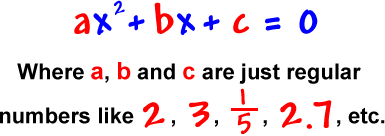Actually, we've already been working with quadratics. They are the trinomial guys we've been factoring:
![]()
![]()
What makes them quadratics is that they are 2nd degree polynomials.
| (They have a squared guy like | |
or | |
.) |
Now, we're going to be solving equations with them like
![]()
![]()
Here's the big official form of a quadratic equation:
 |
Examples:





It would be silly to ever have a = 0 in a quadratic -- Then we wouldn't have a squared guy!